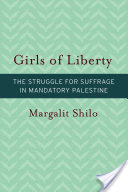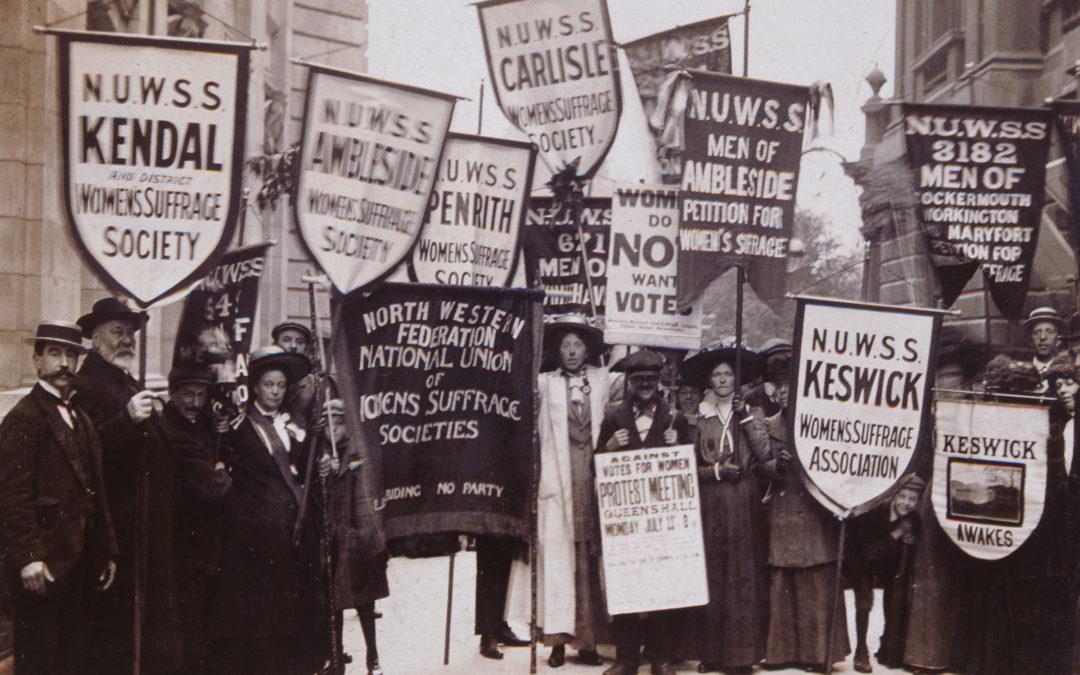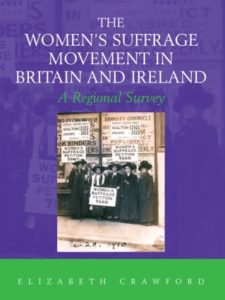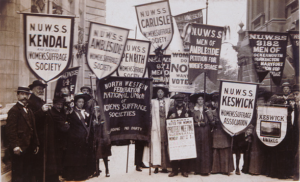By Sara Charles
Although the history of the women’s suffrage movement (and particularly the Suffragettes) often focusses on London, there was huge amount of activity throughout the U.K. and further afield in the latter part of the nineteenth and early twentieth century. An indispensable guide to the nationwide groups can be found in Elizabeth Crawford’s The Women’s Suffrage movement in Britain and Ireland: a regional survey, a book which highlights how women were engaged in the movement throughout the regions.
Manchester in particular was a centre of radical and liberal thinking in the mid nineteenth century, and in 1867 they established the Women’s Suffrage Committee. In the same year, Lily Maxwell, a Manchester shopowner whose name was accidentally added to the electoral roll was allowed to vote at Chorlton Town Hall. Although she probably was not the first female voter in England, her example prompted other female property owners to apply for the vote, who were subsequently denied the vote the following year after the case was heard at the Court of Common Pleas. More about this can be found in the book chapter ‘Who was Lily Maxwell? Women’s suffrage and Manchester politics, 1866–1867’ by Jane Rendall, in Votes for Women.
 The protest movement was also strong even in the remoter areas of Britain, as is demonstrated in the works by Katherine Bradley Friends and visitors: History of the Women’s Suffrage Movement in Cornwall, 1870-1914 and Marsali Taylor Women’s Suffrage in Shetland. The latter demonstrates how the small group of islands willingly adapted to the changes brought by the suffrage movement, founding its own society in 1873 and having women on its education boards at least as early as London. A book by Barbara Lawson-Reay titled Votes for women: North Wales suffragists’ campaign 1907–1914 documents the seven year period before the First World War, when the campaign started as a small cell in Llandudno and subsequently gathered pace across North Wales, despite class and language barriers. Other geographical aspects are explored in an article by J. G. Macdonald in Hawick Archaeological Society Transactions called ‘Women’s suffrage: A Border perspective’. A song of their own : the fight for votes for women in Ipswich is a fascinating book by Joy Bounds, who shows how the women of Ipswich were just as brave as their London contemporaries, standing up to opposition and even violence to attend meetings, fairs and suffrage plays.
The protest movement was also strong even in the remoter areas of Britain, as is demonstrated in the works by Katherine Bradley Friends and visitors: History of the Women’s Suffrage Movement in Cornwall, 1870-1914 and Marsali Taylor Women’s Suffrage in Shetland. The latter demonstrates how the small group of islands willingly adapted to the changes brought by the suffrage movement, founding its own society in 1873 and having women on its education boards at least as early as London. A book by Barbara Lawson-Reay titled Votes for women: North Wales suffragists’ campaign 1907–1914 documents the seven year period before the First World War, when the campaign started as a small cell in Llandudno and subsequently gathered pace across North Wales, despite class and language barriers. Other geographical aspects are explored in an article by J. G. Macdonald in Hawick Archaeological Society Transactions called ‘Women’s suffrage: A Border perspective’. A song of their own : the fight for votes for women in Ipswich is a fascinating book by Joy Bounds, who shows how the women of Ipswich were just as brave as their London contemporaries, standing up to opposition and even violence to attend meetings, fairs and suffrage plays.
Even more interesting is the spread of networks and interaction throughout the wider political world. ‘Woman Suffrage and Irish Nationalism: ethnic appeals and alliances in America’ is an article by Tara McCarthy in Women’s History Review that explores how suffragists sympathised with the Home Rule movement, which led to a group of Irish nationalists and suffragists working together. Also from the same journal, Helen Dampier’s ‘Going on with our little movement in the hum drum-way which alone is possible in a land like this’: Olive Schreiner and suffrage networks in Britain and South Africa, 1905–1913 looks at the letters of South African feminist Olive Schreiner. The article considers the differences between British and colonial suffrage movements, with Schreiner fighting for better education for women so that they wanted the vote. It also highlights Schreiner’s quest for universal suffrage, which brought her into conflict with those who were willing to accept a racially-segregated system.
 Girls of liberty: the struggle for suffrage in Mandatory Palestine is a book by Margalit Shilo that looks at a group of feminist Zionist activists who created a political party under the British Mandate, resulting in equal rights for women in 1918. Sophia: princess, suffragette, revolutionary by Anita Anand is about the extraordinary life of Sophia Duleep Singh, daughter of a maharajah and god-daughter to Queen Victoria, who was raised in England after her father’s Indian lands were plundered by the British. After travelling back to India, she became a pioneer against social injustice and returned to Britain to fight for Indian rights and women’s suffrage. By all accounts, Singh was a fearless champion for the cause, and the book offers an important perspective on British and colonial ties.
Girls of liberty: the struggle for suffrage in Mandatory Palestine is a book by Margalit Shilo that looks at a group of feminist Zionist activists who created a political party under the British Mandate, resulting in equal rights for women in 1918. Sophia: princess, suffragette, revolutionary by Anita Anand is about the extraordinary life of Sophia Duleep Singh, daughter of a maharajah and god-daughter to Queen Victoria, who was raised in England after her father’s Indian lands were plundered by the British. After travelling back to India, she became a pioneer against social injustice and returned to Britain to fight for Indian rights and women’s suffrage. By all accounts, Singh was a fearless champion for the cause, and the book offers an important perspective on British and colonial ties.
To finish with, The role of petitions in the mobilization of women for the right to vote: The case of Queensland, Australia, 1894, 1897 by Deborah Jordan in Journal of Women’s History concentrates on the tactics of suffrage groups, including the Women’s Equal Franchise Association (WEFA) in Brisbane. The article examines the use of petitions, and underlines the success of various groups in gaining support and legitimacy for their cause against a backdrop of harsh media representation.
This selection of resources from the Bibliography demonstrates how widespread women’s suffrage was, from the Shetland Islands to India to Australia, and shows how the movement found common ground with other political campaigns fighting for civil justice.




